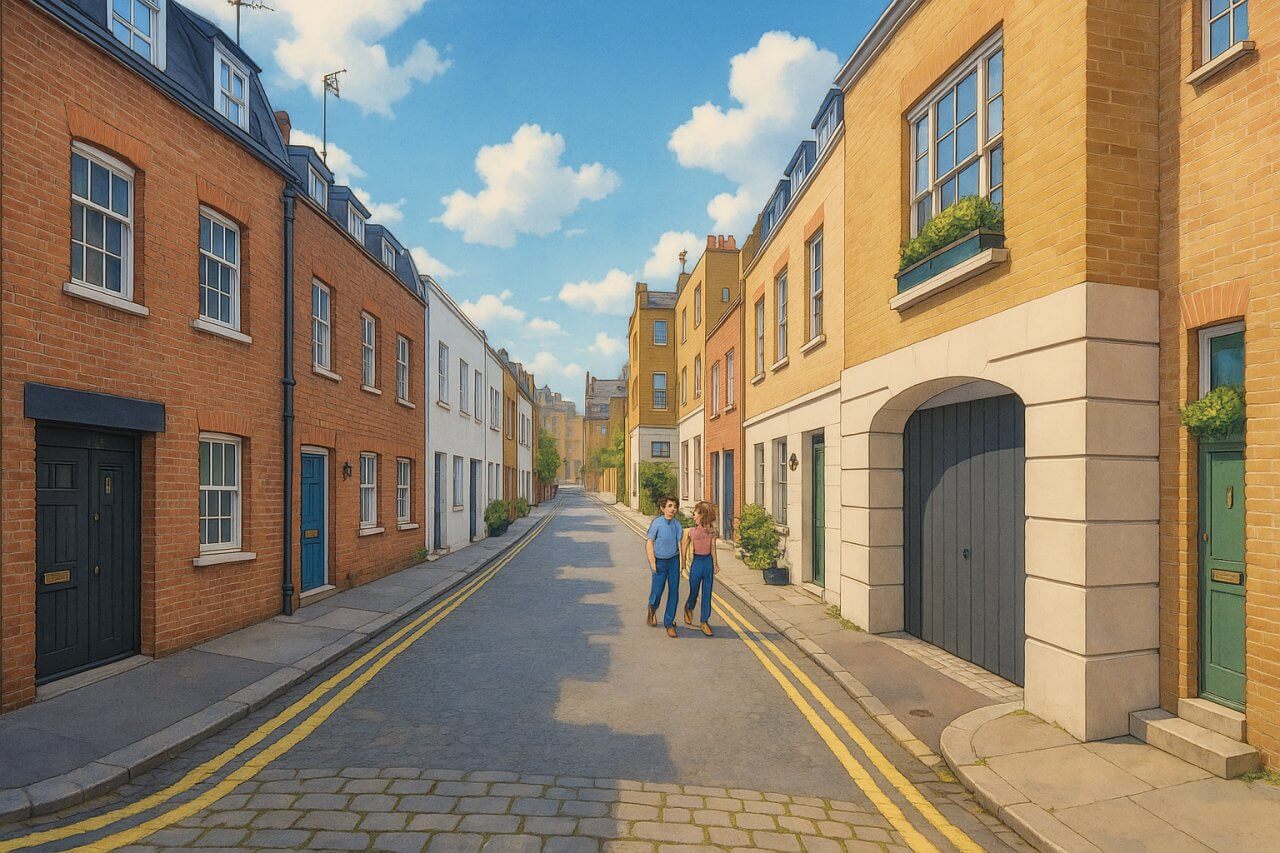
Wilton Mews, London
Wilton Mews is a picturesque mews street in the prestigious district of Belgravia, within the City of Westminster in central London. Nestled between Wilton Street and Chester Street, it offers a quiet, cobbled escape from the bustle of nearby thoroughfares, while remaining only moments from Victoria and Hyde Park Corner.
Location and Layout
Wilton Mews runs in a generally northwest-southeast orientation, connecting Chester Street at its northwestern end to Wilton Street to the southeast. Little Chester Street branches off it in a T-junction, adding a charming visual intersection. The mews is relatively short, measuring approximately 150 metres (about 490 feet) in length.
Traffic flows in a one-way direction from Chester Street down to Wilton Street, typical of many residential mews in Belgravia. Its narrow width and cobbled surface discourage through-traffic, helping preserve its quiet and exclusive character.
History of Wilton Mews
Wilton Mews dates back to the early to mid-19th century, a period when the Belgravia area was being developed under the Grosvenor Estate, overseen by the 1st Marquess of Westminster. Like many other mews in the area, it was originally built to house stables and carriage houses for the grand residences nearby.
As transport evolved and the need for horses diminished, the mews properties were gradually converted into private residences—many beginning transformation in the early 20th century. Today, Wilton Mews represents the classic example of how London mews have transitioned from utilitarian to luxurious.
Origin of the Name
The name Wilton is derived from the adjacent Wilton Street, itself named after Wilton House, the ancestral seat of the Earls of Pembroke, located near Salisbury in Wiltshire. The Wilton family had long-standing ties with the Grosvenor family, developers of much of Belgravia.
Pronunciation: Wilton is commonly pronounced as WILL-t’n (/ˈwɪltən/ in the International Phonetic Alphabet). 
Character and Atmosphere
Wilton Mews exudes a quintessentially Belgravian charm—elegant, refined, and quietly luxurious. The street is cobbled, with charming archways and pastel façades that reflect a village-like ambiance in the heart of London. Many buildings have retained carriage-style entrances, and several include rooftop terraces or rear gardens.
The street is known for its discreet opulence and is favoured by affluent residents seeking privacy, character, and a central location. Despite being just minutes from major London hubs, Wilton Mews maintains a peaceful and almost secretive quality.
Nearby Sights and Attractions
Though Wilton Mews itself is residential, it is ideally situated for access to notable London landmarks. Within walking distance are:
- Belgrave Square – one of London’s grandest garden squares, just a few minutes' walk.
- Buckingham Palace – about 10 minutes away on foot.
- Hyde Park Corner and Green Park – offering open green space and monuments.
- The Goring Hotel and The Lanesborough – luxury hotels with fine dining options.
Additionally, the area is filled with embassies, private clubs, and upscale boutiques, especially around Motcomb Street and Elizabeth Street.
Property and Real Estate
Properties on Wilton Mews are primarily freehold mews houses, many arranged over three or four storeys. Interiors are often highly customised and renovated to luxury standards. Typical internal space ranges between 1,500 to 2,500 sq ft (139 to 232 sq m), although larger examples exist.
As of May 2025, homes in Wilton Mews are valued at approximately £3.5 million to £6 million, depending on size, condition, and garden space. This pricing reflects the premium of Belgravia real estate, which remains one of the most expensive in London and indeed the UK1.
Transport and Accessibility
Underground Stations
- Hyde Park Corner (Piccadilly line) – around 7 minutes’ walk.
- Victoria Station (Victoria, Circle, and District lines) – around 10 minutes’ walk, with National Rail services as well.
- Green Park (Jubilee, Piccadilly, Victoria lines) – approximately 15 minutes away.
Bus Stops
The nearest bus stops are located along Grosvenor Place and Buckingham Palace Road, served by numerous routes including the 2, 16, 38, 52, 73, 82, 148, 170, and 507, offering frequent connections to central and west London.
Fun Fact
Wilton Mews has occasionally served as a filming location and photo shoot setting due to its quintessential mews architecture. The combination of cobbles, historic façades, and tranquil ambiance makes it particularly appealing for scenes requiring a timeless London backdrop.
Quick Facts
- Location: Belgravia, City of Westminster
- Connects: Chester Street (NW) to Wilton Street (SE)
- Nearby streets: Little Chester Street (T-junction)
- Length: Approximately 150 metres (490 feet)
- Traffic: Two-way, NW to SE
- Built: Mid-19th century as part of the Grosvenor Estate
- Name origin: From Wilton Street and Wilton House, home of the Earls of Pembroke
- Pronunciation: WILL-t’n (/ˈwɪltən/)
- Character: Cobblestone mews, elegant homes, quiet and exclusive
- Nearby sights: Belgrave Square, Buckingham Palace, Hyde Park
- Real estate (May 2025): £3.5–£6 million, sizes around 1,500–2,500 sq ft (139–232 sq m)
- Nearest Tube: Hyde Park Corner, Victoria, Green Park
- Nearby buses: Routes via Grosvenor Place and Buckingham Palace Road
- Fun fact: Occasionally used as a filming and photo shoot location
References
Map of Wilton Mews, London

Painting of Wilton Mews, London (View image in full size)